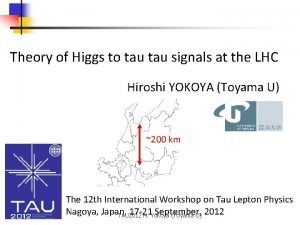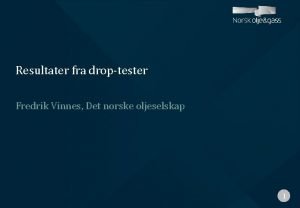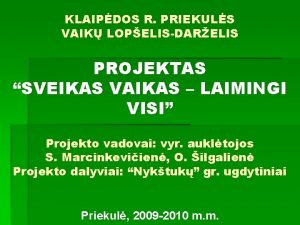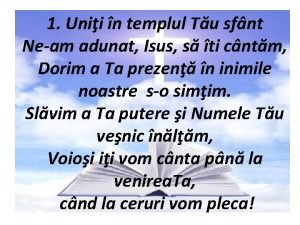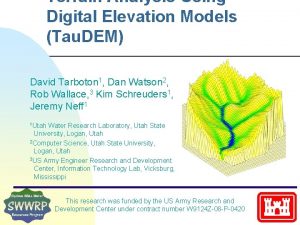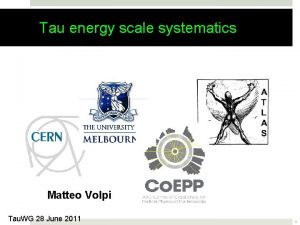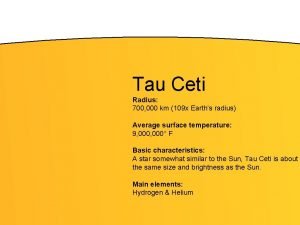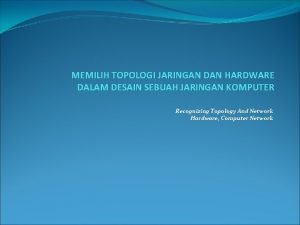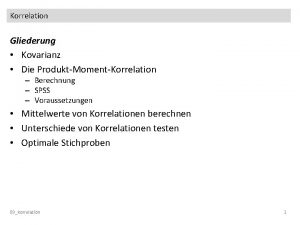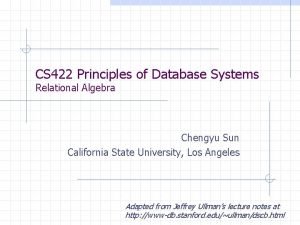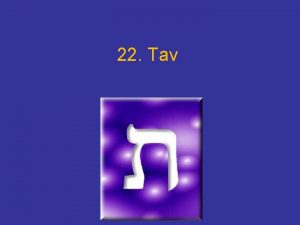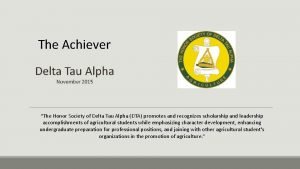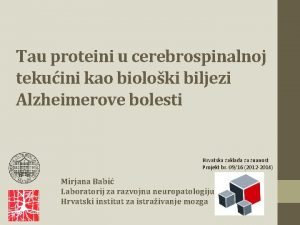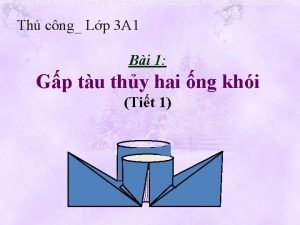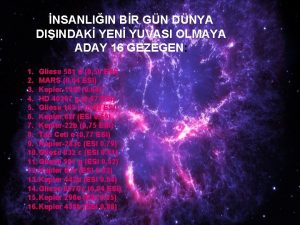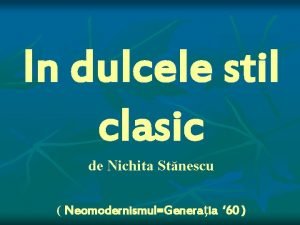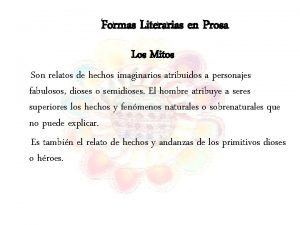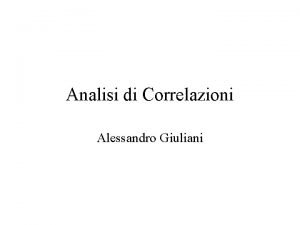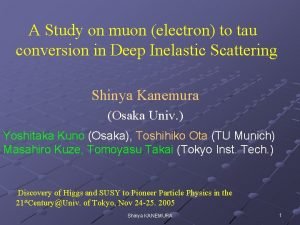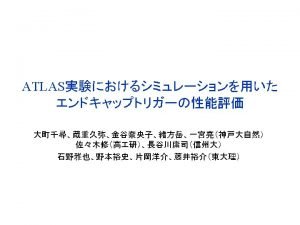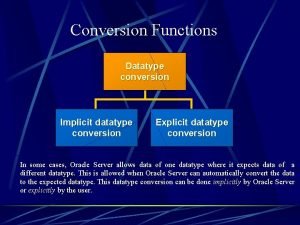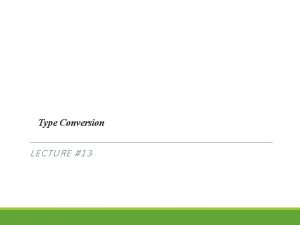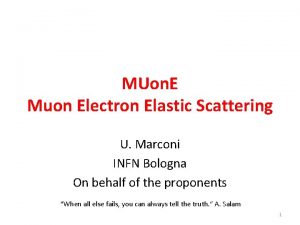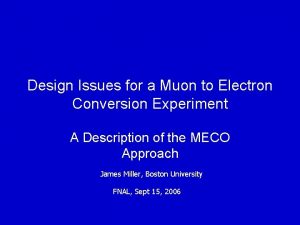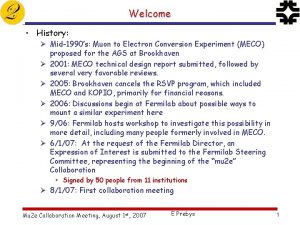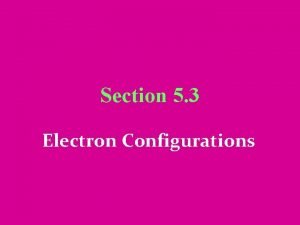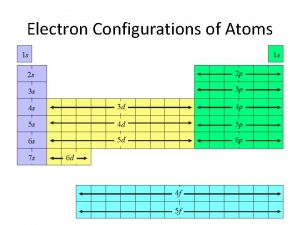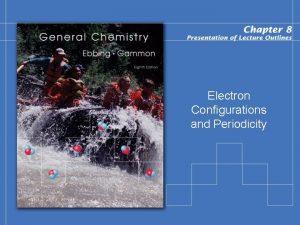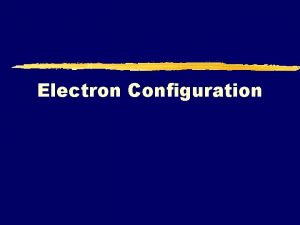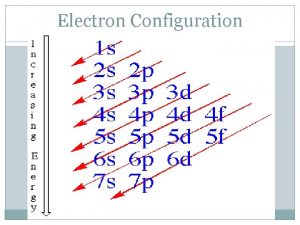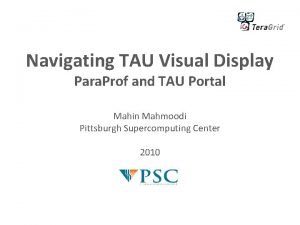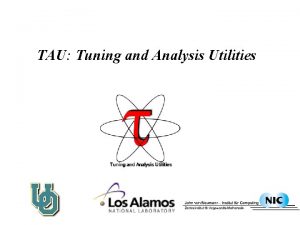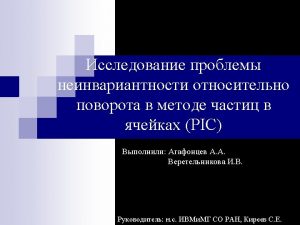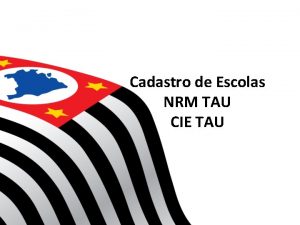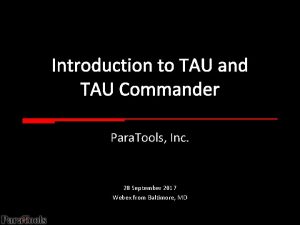A Study on Muon Electron to Tau Conversion





























- Slides: 29

A Study on Muon (Electron) to Tau Conversion In Deep Inelastic Scattering Yoshitaka Kuno (Osaka Univ. ) With S. K. ’s Transparencies (+mod. ) S. Kanemura, YK, T. Ota, M. Kuze PLB 607(2005)165 S. Kanemura, YK, T. Ota, M. Kuze, T. Takai Work in progress At Workshop of “Flavour in the Era of the LHC”, CERN, November 9 th, 2005

Contents Introduction n n Tau associated LFV processes Effective coupling scheme Tau-associated LFV DIS scattering processes n n μN → τ X at a neutrino factory (or a muon collider) PLB 607(2005)165 e. N → τ X at a linear collider (a fixed target experiment at ILC) Summary

Introduction

Physics Motivation LFV is a clear signal for physics beyond the SM. Neutrino oscillation may indicate the possibility of LFV in the charged lepton sector. In new physics models, LFV can naturally appear. n SUSY (slepton mixing) Borzumati, Masiero Hisano et al. n n Zee model for the ν mass Zee Models of dynamical flavor violation Hill et al.

Tau-associated LFV τ ⇔e & τ ⇔μ n n Tau-associated LFV is interesting in the case of the Higgs mediated LFV, which is proportional to the Yukawa coupling. (different behavior from μe mixing case) Tau-associated LFV is less constrained by current data, in comparison to the μ⇔e mixing μ→eγ 1. 2 × 10-11 μ→3 e 1. 1 × 10-12 μTi→e. Ti 6. 1 × 10-13 τ →μγ 3. 1 × 10-7 τ →3μ (1. 4 - 3. 1) × 10-7 τ →μη 3. 4 × 10-7

LFV in SUSY It is known that sizable LFV can be induced at loop due to slepton mixing Up to now, however, no LFV evidence has been observed at experiments. μ→e γ, μ→eee, …. This situation may be explained by large MSUSY, so that the SUSY effects decouple. Even in such a case, we may be able to search LFV through the Higgs boson mediation, which does not necessarily decouple for a large MSUSY limit

Decoupling property of LFV Gauge mediation : Higgs mediation : Higgs mediation does not decouple in the large MSUSY limit

Experimental bound on κ 32, κ 31 The strongest bound on κ 32 comes from the τ →μη result. For κ 31, similar bound is obtained.

Current Data

Search for Higgs mediated τ - e & τ - μ mixing at future colliders Tau rare decays at B factories. τ →eππ (μππ) τ →eη (μη) τ →μee (μμμ), …. In near future, super B-factories may improve the upper limits by about one order of magnitude. We here discuss the other possibilities. n The DIS process μN (e. N)→τ X at a fixed target experiment at a neutrino factory and a LC

Search for LFV Yukawa Coupling μN→τX DIS process at future a neutrino factory (or a muon collider) , about 1020 muons/year of energy 50 Ge. V (or 100500 Ge. V) can be available. eN→τX DIS process at a LC (Ecm=500 Ge. V L=1034/cm 2/s), 1022 electrons/year of 250 Ge. V electrons available. (a fixed target option at ILC).


A Linear Collider (ILC) collision ILC (former JLC, TESLA, NLC) 1 st stage 2 nd stage Roadmap report JLC

Constraints of New Physics on the τμ coupling from Data Scalar coupling Pseudo scalar coupling Vector Pseudo vector τ→μππ Λ~ 2. 6 Te. V τ→μη ~ 12 Te. V τ→μρ ~ 12 Te. V τ→μπ ~ 11 Te. V Black, Han, He, Sher, 2002

Cross Sections with Effective Couplings Scalar coupling ---several 10 -1 fb In SUSY, scalar coupling = pseudo scalar coupling which makes the cross section 10 -4 -10 -5 smaller than scalar coupling bound PDF : CTEQ 6 L

DIS Cross Section Higgs mediated process CTEQ 6 L Each sub-process (e)q →τ q is proportional to the down-type quark masses. For the energy > 60 Ge. V, the total cross section is enhanced due to the b-quark sub-process E = 50 Ge. V 100 Ge. V 250 Ge. V 10 -5 fb 10 -4 fb 10 -3 fb

Angular Distribution (Higgs Mediation) Higgs mediation → chirality flipped → (1-cosθCM) Lab-frame μ τR θ L Target Lab-frame

Energy Distribution at Different Angles p From a left-handed μL beam, τ R is emitted to the backward direction due to (1 ー cosθCM) nature in CM frame. p In Lab-frame, tau is emitted forward direction with some P T. Eμ= 50 Ge. V Eμ= 100 Ge. V Eμ= 500 Ge. V

Contribution of Gauge Boson Mediation τ →eγ results gives the upper bound on the tensor coupling, therefore on the e N →τ X cross section Gauge coupling ⇒ No bottom Yukawa enhancement At high energy, (e)N →τ X DIS process is more sensitive to the Higgs mediation than the gauge mediation.

Muon beam

Signal # of tau for L =10^20 muons |κ 32|^2=0. 3× 10^(-6) (from the present limits) Eμ= 50 Ge. V 100×ρ[g/cm^2] τ’s 100 Ge. V 1000 500 Ge. V 50000 Hadronic products from tau decays τ→π、ρ, a 1, …+ missings Hard hadrons emitted into the same direction as the parent τ’s τR ⇒ backward νL + forward π, ρ、…. Bullock, Hagiwara, Martin

Backgrounds Hard hadrons from the target (N) should not be so serious, and smaller for higher energies of the initial muon beam. Hard muons from DIS μN→μX may fake signal. n n n Rate of mis-ID [machine dependent] Emitted to forward direction without large PT due to Rutherford scattering 1/sin^4(θc. M/2) Energy cuts Realistic Monte Carlo simulation is necessary to see the feasibility

Signal Higgs boson mediation Backgrounds photon mediation usual DIS Different distribution ⇒ BG reduction by Eτ , θτ cuts

Monte Carlo Simulation 500 -Ge. V muon beam Generator: Signal Modified LQGENEP (leptoquark generator) Bellagamba et al Background LEPTO γDIS Q 2>1. 69 Ge. V 2, σ=0. 17μb MC_truth level analysis Work in progress

Electron beam

Number of taus Ee= 250 Ge. V, L =10^34 /cm^2/s, ⇒ 10^22 electrons With the present limit of |κ 31 |^2=0. 3× 10^(-6), the cross section will be σ = 10 -3 fb 105 of τ leptons can be produced for the target of ρ=10 g/cm^2 Naively, non-observation of the high energy muons from the tau of the e N → τ X process may improve the current upper limit on the e-τ-Φcoupling^2 by around 4 -5 orders of magnitude

Signal/Backgrounds Signal: for example, μ from τ in e N→τX Backgrounds: n n n Pion punch-through Muons from Pion decay-in-flight Muon from the muon pair production Monte Carlo Simulation under study n n 50 Ge. V electron beam Event Generator Signal: modified LQGENEP Background: γDIS σ=0. 04μb BG absorber, simulation for the pass through Probability of e, π, μ by using GEANT

High energy muon from tau is a signal Geometry (picture) ex) target ρ=10 g/cm 2 6 -10 m 10 cm e τ target e Backgrounds n n μ dump (water) π Hadron absorber (iron) elemag shower Pion punch-through Muons from Pion decay-in-flight Muons from the muon pair production ……. Monte Carlo simulation by using GEANT Muon spectrometer (momentum measurement)

Summary We discussed LFV via DIS processes μN(e N) →τX using high energy muon and electron beams and a fixed target. For E > 60 Ge. V, the cross section is enhanced due to the sub-process of Higgs mediation with sea b-quarks DIS μN→τX by the intense high energy muon beam. n n n In the SUSY model, 100 -10000 tau leptons can be produced for E μ=50 -500 Ge. V. No signal in this process can improve the present limit on the Higgs LFV coupling by 10^2 – 10^4. Theτ is emitted to forward direction with ET The signal is hard hadrons from τ→πν、ρν, a 1ν, . . , which go along the τdirection. Main background: mis-ID of μ in μN→μX…. DIS process e N →τX : n n At a LC with Ecm=500 Ge. V ⇒ σ= 10^(-3) fb L=10^34/cm^2/s ⇒ 10^22 electrons available 10^5 of taus are produced for ρ=10 g/cm^2 Non-observation of the signal (high-energy muons) would improve the current limit by 10^4. Realistic simulation: work in progress.
 Higgs to tau tau
Higgs to tau tau Karakia opening
Karakia opening Karakia whakamutunga kia tau
Karakia whakamutunga kia tau Elastisk tau biltema
Elastisk tau biltema Labas rytas tau galvyte
Labas rytas tau galvyte Ai promis c-ai sa revii
Ai promis c-ai sa revii Tetrathlon olympics
Tetrathlon olympics Tau dem
Tau dem Tau energi
Tau energi Tau ceti distance to earth
Tau ceti distance to earth Memilih
Memilih Biseriale korrelation
Biseriale korrelation Ksi letra grega
Ksi letra grega Delta relational algebra
Delta relational algebra Letra tav significado
Letra tav significado Delta tau alpha honor society
Delta tau alpha honor society Tau proteini
Tau proteini Tau beta sigma 8 and 5
Tau beta sigma 8 and 5 Malanga fakaosi tau
Malanga fakaosi tau Runa not
Runa not Tizen advanced ui
Tizen advanced ui Gấp tàu thủy hai ống khói
Gấp tàu thủy hai ống khói Sen tau
Sen tau Tau ceti e
Tau ceti e Nichita stanescu in dulcele stil clasic
Nichita stanescu in dulcele stil clasic Leyenda en prosa
Leyenda en prosa Tau tangles
Tau tangles Kendall's tau formula
Kendall's tau formula Upper ngau tau kok estate
Upper ngau tau kok estate Short karakia for meetings
Short karakia for meetings
